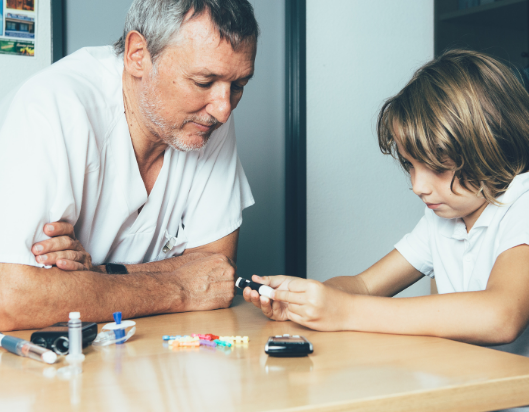Diabetes type 1

Type 1 diabetes occurs when the body stops producing an important hormone called insulin. It is mostly diagnosed in childhood and requires life-long insulin therapy.
In type 1 diabetes, the body’s immune system attacks cells that make insulin. Insulin allows the body to use sugar (glucose) from carbohydrates in food for energy.
Without insulin, glucose builds up in the blood causing high blood sugar (hyperglycaemia). Left untreated, undiagnosed type 1 diabetes can cause many health problems including diabetic ketoacidosis (DKA) which can lead to coma and death.
Children with type 1 diabetes must regularly test their blood glucose levels and have insulin therapy via injections or an insulin pump. Too much insulin can cause low blood sugar levels (hypoglycaemia) with symptoms including drowsiness and slurred speech.
There is currently no cure for type 1 diabetes but the tools to manage it are constantly improving.

Who does it affect?
Who does it affect?
- Half of all type 1 diabetes is diagnosed in children aged less than 18 years.
- More than 90 per cent of children and teenagers with diabetes have type 1 diabetes – also called juvenile diabetes – but we do not know what causes the condition.
- In Australia, about 6,500 children under 14 have type 1 diabetes.
Our Diabetes type 1 research
Our Diabetes type 1 research
Our research covers three broad areas:
Type 1 diabetes and the brain
Using psychological tests and brain imaging techniques, we are documenting long and short-term impacts of unstable glucose levels on the brains of children and adolescents with diabetes. So far, we have discovered that swinging blood sugar levels disrupt the developing brains of children with this condition. We also found the disease can significantly impact brain function and mental health.
Islet damage in type 1 diabetes
We are using pioneering technology to take cells from children with diabetes and turn them into stem cells, also known as ‘seed’ cells, that can develop into different cell types. In the laboratory, we use stem cells to recreate the cells that make insulin and cells of the immune system. By studying these cells outside the body, we hope to gain a better understanding of processes that lead to type 1 diabetes.
Type 1 diabetes technologies
We are evaluating the usefulness of diabetes-related technologies including insulin pumps and continuous glucose monitors. This includes determining their impact on health outcomes and studying how these technologies affect quality of life.
Impacts of our research

Impacts of our research
- We have identified that children with diabetes lose one-third of a standard deviation in full-scale IQ during development. One-third of children with diabetes develop a mental health disorder, one-third do not finish high school, and one-third struggle to stay in medical care as adults.
- We have highlighted that diabetic ketoacidosis has a significant medium-term impact on brain function.
- Using brain scans we investigated problem-solving ability during lowered and raised blood glucose levels showed blood sugar levels of children with diabetes. Even when the children had recovered and their blood sugar had returned to normal, their brains had not fully recovered.
- We have used stem cells to produce human immune cells and insulin-producing in the laboratory. We plan to combine these cells together to reveal what causes immune cells to mistakenly kill insulin-producing cells. Understanding this process will help us design strategies to prevent the immune attack and enable us to test new treatments.
- We found that patient attitude rather than technology type is the main factor determining health outcomes when using technology.
- We have seen marginal but consistent benefits with each new technology.
Our vision
Our vision
Our vision is to devise a therapy that protects the developing brains of children and adolescents with type 1 diabetes regardless of blood glucose control, and to define which technologies will assist individuals.
Using stem cell-models, we aim to identify strategies that impact the immune system to prevent diabetes.
Where to next?
Where to next?
It is our goal to create a complete physiological, psychological, and cellular picture of how type 1 diabetes affects children and to ensure they have access to the most up-to-date information and treatments. This means ensuring seamless lines of communication between clinical and research groups, enabling them to work together to bring the best possible outcomes for children with Type 1 Diabetes.




